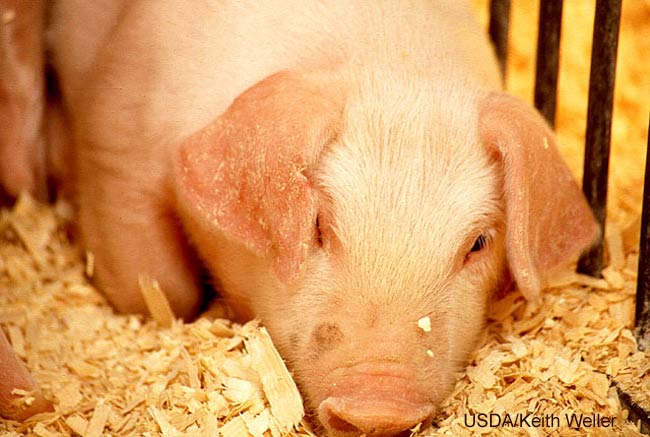Banned in 160 Nations, Why is Ractopamine in U.S. Pork? (Op-Ed)


Wayne Pacelle is the president and chief executive officer of The Humane Society of the United States (HSUS). Pacelle contributed this Op-Ed to Live Science's Expert Voices: Op-Ed & Insights.
If you care about the drugs that make it into the United States' food supply — or only about what happens to the animals that supply us with meat — you should care about ractopamine. Because of safety concerns, about 160 nations ban or restrict the use of this drug during pig production, including all countries in the European Union, Russia and China. But that hasn't stopped the U.S. pork industry from feeding it to an estimated 60 percent to 80 percent of American pigs to rapidly boost growth rates. If you buy pork at your local supermarket, chances are that it came from a ractopamine-treated pig.
A few days ago, McClatchy published a detailed piece on how the American pork industry — led by the National Pork Producers Council (NPPC) — now is demanding that European authorities allow pork from pigs fed ractopamine into their market. The European Food Safety Authority investigated ractopamine in 2009, concluding there were not enough data to show that it is safe for human consumption at any level. But the NPPC is now urging U.S. trade negotiators to override that determination in current trade talks with the European Union. The NPPC's attitude appears to be that that the pork industry's profits should trump any concerns about food safety or animal welfare from regulators, scientists or consumers.
There are serious questions about ractopamine's safety. It belongs to a class of drugs, beta-agonists, that were developed to treat asthma and only adapted for animal use when they were shown to boost growth rates. The U.S. Food and Drug Administration (FDA) approved ractopamine for use on pigs after just one human health study — an evaluation of six young, healthy men, one of whom dropped out because his heart began racing and pounding abnormally. Three years later, the FDA sent ractopamine's sponsor a 14-page letter, accusing the company of withholding information about the drug's "adverse animal drug experiences" and "safety and effectiveness." Shortly thereafter, the FDA required drug manufacturers to add this warning label: "Ractopamine may increase the number of injured and/or fatigued pigs during marketing. Not for use in breeding swine." [Memo to Congress: Protect Public Health, Not Toxic Chemicals (Op-Ed )]
The FDA has linked ractopamine to nearly a quarter-million reported adverse events in pigs (more than half of those pigs were sickened or killed) — more than any other animal drug. These pigs became lame or unable to stand, started trembling, or suffered a host of other ailments.
In particular, ractopamine causes pigs to collapse and become "downers," that is, animals too sick or injured to walk, and then often dragged into the slaughterhouse. HSUS investigations at pig factory-farms have shown that these downer pigs are often terribly and cruelly mishandled. The pork industry vehemently fights all of our efforts to require the euthanasia of downer pigs, perhaps because it realizes that there are so many downers now that the use of ractopamine is so routine.
The dispute over ractopamine speaks to a broader illness in the nation's pork industry. The pork industry insists on using a dangerous drug and then complains when other nations and American consumers don't want their pork. They have some sort of expectation that they know best, behaving like parents insisting that their unknowing children eat whatever is on their plate.
Get the world’s most fascinating discoveries delivered straight to your inbox.
This reminds me of the pork industry's stubborn refusal to stop using gestation crates — coffin-sized crates that confine pregnant sows so tightly that they can't even turn around. Polls show that consumers in every state oppose their continued use, while almost 60 major food corporations have committed to phasing out the crates based on their cruelty. But still the pork industry, and especially the NPPC, continues to cling to the crates — which they are now, laughably, trying to rebrand as "maternity pens." This mentality is best summed up by an NPPC spokesman who told a reporter in 2012: "So our animals can't turn around for the 2.5 years that they are in the stalls producing piglets. I don't know who asked the sow if she wanted to turn around…" [Gestation Crates Have No Place in U.S. Food Production (Op-Ed )]
Thankfully, this line of thinking now faces a major challenge from within the pork industry, with major producers splitting from the NPPC on gestation crates and ractopamine. Smithfield Foods, for example, has committed to phasing out all of its gestation crates and to reducing its use of ractopamine. And just last month, we were pleased to announce that Cargill is following suit in eliminating gestation crates. Now it's time for the pork industry's laggards to step up, and for the obstructionists at the NPPC to get out of the way.
Pacelle's most recent Op-Ed was "Yes, You Can Get Your Cat to Behave." The views expressed are those of the author and do not necessarily reflect the views of the publisher. This version of the article was originally published on Live Science.



